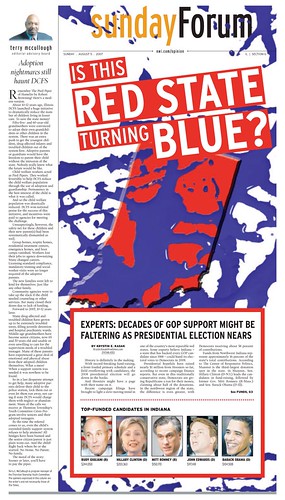 This goes SO MUCH DEEPER than the red state blue state political dichotomy that's used to delineate the phenomenon. I heard the story on Talk of the Nation on my way to a meeting downtown yesterday and couldn't wait to post it for your consideration this morning. Well worth your listen I believe.
This goes SO MUCH DEEPER than the red state blue state political dichotomy that's used to delineate the phenomenon. I heard the story on Talk of the Nation on my way to a meeting downtown yesterday and couldn't wait to post it for your consideration this morning. Well worth your listen I believe. In 1976, less than a quarter of Americans lived in places where the presidential election was a landslide. By 2004, nearly half of all voters lived in landslide counties. When people move, they also make choices about who their neighbors will be and who will share their new lives. Those are now political decisions, and they are having a profound effect on the nation's public life. It wasn't just my neighborhood that had tipped to become politically monogamous.
Discovering the Big Sort
The "red" and "blue" states shown on television maps during the past several national elections depict a country in a static standoff. On this scale, politics is a game of Risk. What will it take for Republicans to capture Michigan? For Democrats to regain Ohio? But people don't live in states. They live in communities. And those communities are not close to being in equipoise, even within solidly blue or red states. They are, most of them, becoming even more Democratic or Republican. As Americans have moved over the past three decades, they have clustered in communities of sameness, among people with similar ways of life, beliefs, and, in the end, politics. Little, if any, of this political migration was by design, a conscious effort by people to live among like-voting neighbors. When my wife and I moved to Austin, we didn't go hunting for the most Democratic neighborhood in town. But the result was the same: moving to Travis Heights, we took a side and fell into a stark geographic pattern of political belief, one that has grown more distinct in presidential elections since 1976.The political *sort* is symptomatic of far deeper psychological tendencies emergent in collectives. These authors have drilled down to some extent on the phenomenon, but the questions left begging are rather dazzling.
Over the past thirty years, the United States has been sorting itself, sifting at the most microscopic levels of society, as people have packed children, CDs, and the family hound and moved. Between 4 and 5 percent of the population moves each year from one county to another — 100 million Americans in the past decade. They are moving to take jobs, to be close to family, or to follow the sun. When they look for a place to live, they run through a checklist of amenities: Is there the right kind of church nearby? The right kind of coffee shop? How close is the neighborhood to the center of the city? What are the rents? Is the place safe?


0 comments:
Post a Comment